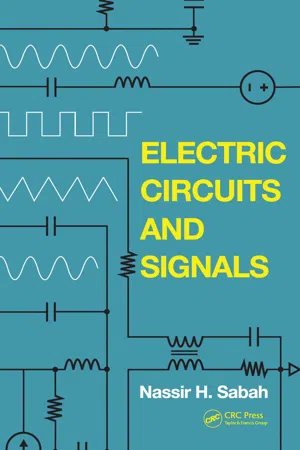Physics
Non Linear Op Amp
A non-linear op amp is an operational amplifier whose output does not have a linear relationship with its input. In other words, the output voltage does not change in direct proportion to the input voltage. Non-linear op amps are often used in applications where precise control and manipulation of signals are required, such as in audio processing and instrumentation.
Written by Perlego with AI-assistance
Related key terms
Related key terms
1 of 4
Related key terms
1 of 3
5 Key excerpts on "Non Linear Op Amp"
- eBook - ePub
- Nassir H. Sabah(Author)
- 2017(Publication Date)
- CRC Press(Publisher)
18Signal Processing Using Operational Amplifiers
Overview
An operational amplifier, or op amp for short, is a high-gain voltage amplifier, designed to amplify signals in the frequency range from dc to a specified upper frequency. Operational amplifiers are so called because they were initially introduced to perform mathematical operations — such as addition, subtraction, differentiation, and integration — in analog computers that were commonly used to solve differential equations, before digital computers prevailed. Nowadays, op amps of high performance and low cost are widely available in integrated-circuit (IC) form, which makes them an important building block in a variety of signal-processing applications. A number of these applications are considered in this chapter.The most important feature of linear op amp circuits is the use of negative feedback to trade-off the high gain of the op amp for some desirable feature, thereby allowing such operations as precision amplification and integration. Op amps are at the heart of active filters of various types, whose performance is superior in many respects to that of passive filters, particularly in their allowing high Q - eBook - ePub
Introduction to Energy, Renewable Energy and Electrical Engineering
Essentials for Engineering Science (STEM) Professionals and Students
- Ewald F. Fuchs, Heidi A. Fuchs(Authors)
- 2020(Publication Date)
- Wiley(Publisher)
8 Operational Amplifiers8.1 Introduction
The operational (OP) amplifier is a basic building block for the design of analog electronic systems such as feedback control circuits [1 ], where the angular velocity ω m (t), angular position θ m (t) = ∫ω m (t)dt, current i(t), and torque T(t) must be controlled. An OP amplifier with no external circuitry is a voltage amplifier with a very high open‐loop voltage gain that ideally approaches infinity A v → ∞, as shown in a symbolic manner in Figure 8.1 . Note that input/output voltages can be either time varying or time independent, and they can be either periodic or nonperiodic.OP amplifiers are integrated circuits (IC), which can be purchased off the shelf, and they contain transistors, diodes, resistors, and capacitors all fabricated on a single silicon chip. Inductors are bulky and are mostly avoided in OP amplifier designs. The analog electronic circuit of Figure 8.1 has two inputs: a negative (v − ) and a positive (v + ) input supplied by the voltages v in1 and v in2 , respectively, whose difference in voltage (v in2 − v in1 ) produces an output signal voltage v out that is a replica of the input voltage difference. The two‐input voltage approach is useful because stray signals/electric noise that appear on both inputs are cancelled, and only the voltage difference is amplified. An OP amplifier is also called a differential amplifier because the output voltage is a voltage that is A v times the voltage difference between the two inputs. During the past half century, OP amplifiers have been refined and improved to the extent that they have nearly ideal properties, and therefore we discuss in this textbook the performance of ideal OP amplifiers only. The understanding of nonideal properties of OP amplifiers requires detailed electronic knowledge [2 - eBook - ePub
Electronics
from Classical to Quantum
- Michael Olorunfunmi Kolawole(Author)
- 2020(Publication Date)
- CRC Press(Publisher)
7 ; depending on the type), and will maintain a very small difference in input terminal voltages when operating in its linear region.An infinite input resistance (R in = ∞).This means that there is no current flow into either input terminal.Zero output resistance (As such, it can supply as much current as necessary to the load being driven.Ro= 0)- An offset: the output will be zero when a zero signal appears between the inverting and non-inverting inputs.
- Zero response time. The output must occur at the same time as the inverting input so the response time is assumed to be zero. Phase shift will be 180°.
Passage contains an image
4.2.1.1 Non-Inverting Amplifier
Figure 4.4a shows a basic, non-inverting amplifier. As noted earlier above, in the triangular symbol, the input terminal marked with a “+” (corresponding to V + ) is called the non-inverting input, while the input terminal marked with a “−” (corresponding to V − ) is called the inverting input. To ensure a non-inverted output signal, the input signalVsis connected to the (+) input terminal of the amplifier. To understand how the non-inverting amplifier circuit works, we need to derive a relationship between the input voltageVsand the output voltageVo - eBook - ePub
- Clive Maxfield, John Bird, Tim Williams, Walt Kester, Dan Bensky(Authors)
- 2011(Publication Date)
- Newnes(Publisher)
Chapter 11 Analog Electronics Mike Tooley and Tim WilliamsThe operational amplifier is the basic building block for analog circuits, and progress in op-amp performance is the “litmus test” for analog IC electronics technology in much the same way as progress in memory devices is for digital electronics technology. This chapter will be devoted to op-amps and comparators, with a tailpiece on voltage references.11.1 Operational Amplifiers Defined
Operational amplifiers (Figure 11.1 ) are analog integrated circuits designed for linear amplification that offer near-ideal characteristics (virtually infinite voltage gain and input resistance coupled with low output resistance and wide bandwidth).Figure 11.1 A typical operational amplifier. This device is supplied in an 8-pin dual-in-line (DIL) package. It has a JFET input stage and produces a typical open-loop voltage gain of 200,000Operational amplifiers can be thought of as universal “gain blocks” to which external components are added in order to define their function within a circuit. By adding two resistors, we can produce an amplifier having a precisely defined gain. Alternatively, with two resistors and two capacitors we can produce a simple band-pass filter. From this you might begin to suspect that operational amplifiers are really easy to use. The good news is that they are!11.2 Symbols and Connections
The symbol for an operational amplifier is shown in Figure 11.2 . There are a few things to note about this. The device has two inputs and one output and no common connection. Furthermore, we often don’t show the supply connections—it is often clearer to leave them out of the circuit altogether!Figure 11.2 Symbol for an operational amplifierIn Figure 11.2 , one of the inputs is marked “-” and the other is marked “+”. These polarity markings have nothing to do with the supply connections—they indicate the overall phase shift between each input and the output. The “+” sign indicates zero phase shift while the “-” sign indicates 180° phase shift. Since 180° phase shift produces an inverted waveform, the “-” input is often referred to as the inverting input . Similarly, the “+” input is known as the non-inverting - David Terrell(Author)
- 1996(Publication Date)
- Newnes(Publisher)
CHAPTER TENNonideal Op Amp Characteristics
For purposes of analysis and design in the preceding chapters, we considered many of the op amp parameters to be ideal. For example, we generally assumed the input bias current to be 0, we frequently ignored output resistance, and we disregarded any effects caused by drift or offset voltage. This approach not only greatly simplifies the analysis and design techniques, but is a practical method for many situations. Nevertheless, more demanding applications require that we acknowledge the existence of certain nonideal op amp characteristics. This chapter will describe many of these additional considerations.10.1 NONIDEAL DC CHARACTERISTICS
We will classify the nonideal characteristics of op amps into two general categories: DC and AC. Let us first consider the effects of nonideal DC characteristics.10.1.1 Input Bias Current
As briefly noted in Chapter 1 , the first stage of an op amp is a differential amplifier. Figure 10.1 shows a representative circuit that could serve as an op amp input stage. Clearly, the currents that flow into or out of the inverting (−) and noninverting (+) op amp terminals are actually base current for the internal transistors. So, for proper operation, we must always insure that both inputs have a DC path to ground. They cannot be left floating, and they cannot have series capacitors. These currents are very small (ideally 0), but may cause undesired effects in some applications.FIGURE 10.1 A representative input stage for a bipolar op amp.Figure 10.2 can be used to show the effect of nonideal bias currents. It illustrates a basic op amp configured as either an inverting or a noninverting amplifier with the input signal removed (i.e., input shorted to ground). The direction of current flow for the bias currents and the resulting output voltage polarities are essentially arbitrary, since different op amps have different directions of current flow. However, for a given op amp, both currents will flow in the same direction (i.e., either in or out). For our immediate purposes, let us assume that the arrows on the current sources indicate the direction of electron flow. We will now apply Ohm’s Law in conjunction with the Superposition Theorem to determine the output voltage produced by the bias currents. First, the noninverting bias current (with the inverting bias current set to 0) will cause a voltage drop acrossRB
Index pages curate the most relevant extracts from our library of academic textbooks. They’ve been created using an in-house natural language model (NLM), each adding context and meaning to key research topics.
Explore more topic indexes
Explore more topic indexes
1 of 6
Explore more topic indexes
1 of 4




